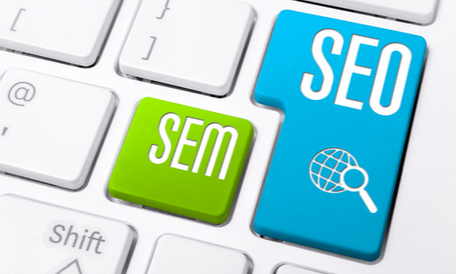Finding success involves a well-studied strategy for any kind of business. One of the key points of a successful digital marketing strategy is web search positioning. Let’s look at some facts: each second, almost 85,282 searches are done on Google, as per Internet Live Stats. So if your website does not appear on Google’s search results, be sure that you are already losing thousands of potential opportunities.
Here, your main goal is to optimize your website for it to appear on the top results in any search engine. Search Engine Optimization (SEO) and Search Engine Marketing (SEM) both play an important role in getting your website center stage. Yet, they are simultaneously different.
Search Engine Optimization

One way of appearing in search results is by improving your search engine rankings. Generally, you can do this through SEO. Working on your SEO means increasing the quality and quantity of traffic to your website through on-page and off-page search engine optimization. And the best thing is: It’s free! In fact, this method focuses on organic activities, it allows your customers to visit your website naturally, over time. With organic SEO, people will find your website easily on search engines, which makes it an important part of any digital marketing plan.
Moreover, people won’t search for something on Google that they don’t need/ want. Therefore, when your website ranks on the front page of a search engine, it will most likely get relevant traffic and potential customers.
Finally, ranking high on search engines allows you to show your potential customers the legitimacy of your website. However, in order to maintain a high ranking, the efforts you put on your SEO should be consistent. As the competition in search engine rankings is increasing, getting a better rank is a task you need to work on daily.
I had previously discussed the different steps you should take to optimize your pages, You can check the article here.
To summarize, organic search engine optimization takes time, patience and consistency. Results don’t happen overnight! Although working on your SEO is a long process, never forget that optimizing your pages will lead to converting your audience from visitors to customers organically.
Seach Engine Marketing

By definition, SEM is a marketing tactic used to optimize and advertise the website in order to appear higher in search results. Simply put, SEM refers to paid ads on search engines to attract potential customers and generate traffic to your website.
With SEM, brands pay for ads to appear as search results on the search engine’s result pages (SERP). The first step to drive a successful SEM campaign is to to select keywords relevant to your brand. Keep your potential customers in mind! What are the words they will most likely use to search for a product you provide? Think about it and start writing your keywords. For example, if you are an E-Commerce selling Women’s shoes, think of keywords such as: woman evening shoes, online shoes for women… At this point, when a woman searches for those terms, she will see your ad. And guess what? You will only be charged should she click on your ad. This is what pay-per-click (PPC) means and why companies tend to go for SEM as a cost-friendly solution to their strategy.
You can find paid search ads at the top or bottom of the search engine’s page. The word “Ad” is mentioned to let the user know that this is paid.

Many companies focus on SEM in order to reach one goal: more website traffic. Yet, you can also use this marketing tactic to:
- Sell products
- Build a brand
- Divert traffic from competitors.
Basically, SEM allows your content to be optimized for high search ranking and places it front and center to your audience. If you want to drive traffic to your website at the soonest, you can conduct a successful SEM campaign today. It doesn’t need that much time and if you do it right, search engine marketing can deliver amazing results overnight.
SEO vs SEM

Both tactics have the exact same aim: making your website more visible to search engines. They can each be a valuable component of your marketing plan if you use them properly. The key point of difference is the nature of traffic generated. While SEO draws the relevant audience organically; SEM lures audience through paid traffic to the website. And this is why many companies tend to use SEO over SEM. However, keep in mind that time is money! Althought SEO is a non-paid technique, getting the results you want will take you lots of time. On the contrary, with SEM, your paid ads will start generating revenue very quickly!
To Conclude
To each its own qualities yet they are equally important. Merging SEO and SEM techniques in your digital marketing strategy will generate high results over time and ensure a favorable growth in your online performance. Contact Brain Space today and see how our SEO & SEM specialists can help you successfully implement both!



